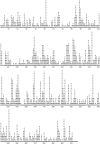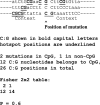Mutational signatures and mutable motifs in cancer genomes
- PMID: 28498882
- PMCID: PMC6454500
- DOI: 10.1093/bib/bbx049
Mutational signatures and mutable motifs in cancer genomes
Abstract
Cancer is a genetic disorder, meaning that a plethora of different mutations, whether somatic or germ line, underlie the etiology of the 'Emperor of Maladies'. Point mutations, chromosomal rearrangements and copy number changes, whether they have occurred spontaneously in predisposed individuals or have been induced by intrinsic or extrinsic (environmental) mutagens, lead to the activation of oncogenes and inactivation of tumor suppressor genes, thereby promoting malignancy. This scenario has now been recognized and experimentally confirmed in a wide range of different contexts. Over the past decade, a surge in available sequencing technologies has allowed the sequencing of whole genomes from liquid malignancies and solid tumors belonging to different types and stages of cancer, giving birth to the new field of cancer genomics. One of the most striking discoveries has been that cancer genomes are highly enriched with mutations of specific kinds. It has been suggested that these mutations can be classified into 'families' based on their mutational signatures. A mutational signature may be regarded as a type of base substitution (e.g. C:G to T:A) within a particular context of neighboring nucleotide sequence (the bases upstream and/or downstream of the mutation). These mutational signatures, supplemented by mutable motifs (a wider mutational context), promise to help us to understand the nature of the mutational processes that operate during tumor evolution because they represent the footprints of interactions between DNA, mutagens and the enzymes of the repair/replication/modification pathways.
Figures






Similar articles
-
Analysis of mutational signatures in C. elegans: Implications for cancer genome analysis.DNA Repair (Amst). 2020 Nov;95:102957. doi: 10.1016/j.dnarep.2020.102957. Epub 2020 Aug 28. DNA Repair (Amst). 2020. PMID: 32980770 Review.
-
Impact of cancer mutational signatures on transcription factor motifs in the human genome.BMC Med Genomics. 2019 May 20;12(1):64. doi: 10.1186/s12920-019-0525-4. BMC Med Genomics. 2019. PMID: 31109337 Free PMC article.
-
Sequence dependencies and mutation rates of localized mutational processes in cancer.Genome Med. 2023 Aug 17;15(1):63. doi: 10.1186/s13073-023-01217-z. Genome Med. 2023. PMID: 37592287 Free PMC article.
-
decompTumor2Sig: identification of mutational signatures active in individual tumors.BMC Bioinformatics. 2019 Apr 18;20(Suppl 4):152. doi: 10.1186/s12859-019-2688-6. BMC Bioinformatics. 2019. PMID: 30999866 Free PMC article.
-
Significance and limitations of the use of next-generation sequencing technologies for detecting mutational signatures.DNA Repair (Amst). 2021 Nov;107:103200. doi: 10.1016/j.dnarep.2021.103200. Epub 2021 Aug 5. DNA Repair (Amst). 2021. PMID: 34411908 Free PMC article. Review.
Cited by
-
Guidelines for DNA recombination and repair studies: Cellular assays of DNA repair pathways.Microb Cell. 2019 Jan 7;6(1):1-64. doi: 10.15698/mic2019.01.664. Microb Cell. 2019. PMID: 30652105 Free PMC article. Review.
-
Finding driver mutations in cancer: Elucidating the role of background mutational processes.PLoS Comput Biol. 2019 Apr 29;15(4):e1006981. doi: 10.1371/journal.pcbi.1006981. eCollection 2019 Apr. PLoS Comput Biol. 2019. PMID: 31034466 Free PMC article.
-
Nucleotide Weight Matrices Reveal Ubiquitous Mutational Footprints of AID/APOBEC Deaminases in Human Cancer Genomes.Cancers (Basel). 2019 Feb 12;11(2):211. doi: 10.3390/cancers11020211. Cancers (Basel). 2019. PMID: 30759888 Free PMC article.
-
DNA damage response alterations in clear cell renal cell carcinoma: clinical, molecular, and prognostic implications.Eur J Med Res. 2024 Feb 7;29(1):107. doi: 10.1186/s40001-024-01678-x. Eur J Med Res. 2024. PMID: 38326910 Free PMC article.
-
DNA Damage Tolerance Pathways in Human Cells: A Potential Therapeutic Target.Front Oncol. 2022 Feb 7;11:822500. doi: 10.3389/fonc.2021.822500. eCollection 2021. Front Oncol. 2022. PMID: 35198436 Free PMC article. Review.
References
-
- Neuberger MS, Harris RS, Di Noia J, et al.Immunity through DNA deamination. Trends Biochem Sci 2003;28:305–12. - PubMed
-
- Matsumoto Y, Marusawa H, Kinoshita K, et al.Helicobacter pylori infection triggers aberrant expression of activation-induced cytidine deaminase in gastric epithelium. Nat Med 2007;13:470–6. - PubMed
-
- Prolla TA. DNA mismatch repair and cancer. Curr Opin Cell Biol 1998;10:311–16. - PubMed
Publication types
MeSH terms
Substances
Grants and funding
LinkOut - more resources
Full Text Sources
Other Literature Sources
Miscellaneous

